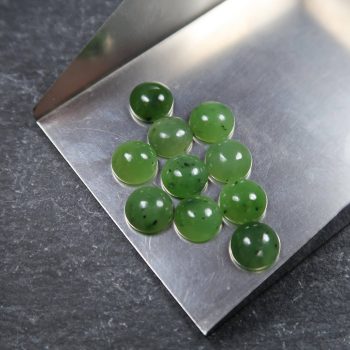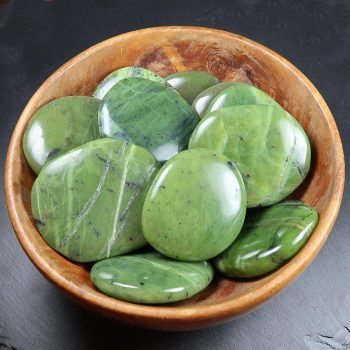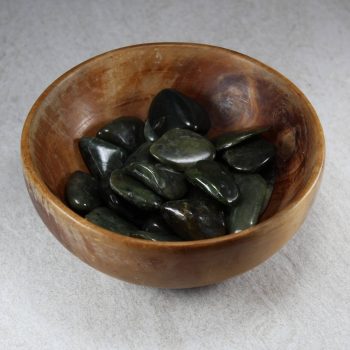Nephrite Jade
Nephrite Jade is one of the two materials commonly referred to as Jade. The other is Jadeite.
Nephrite Jade is significantly more common than Jadeite. It typically occurs as a translucent rock with black and darker inclusions, giving it a mottled effect. There can be a considerable variety of colours, from very light green to a darker green, almost black. The translucency does vary pretty widely, too.
Showing all 3 results
-

Nephrite Jade Cabochons
Price range: £1.70 through £15.00 -

Nephrite Jade Palmstones
Price range: £4.00 through £5.00 -

Nephrite Jade Tumblestones
Price range: £3.00 through £12.00
Information about Nephrite Jade
Nephrite is a tough, compact rock primarily made up of amphiboles of the actinolite-tremolite series. It is most commonly found in shades of green, from pale to dark, but it can also appear white, gray, yellow, or brown.
Uses and History
Nephrite has been used for thousands of years for tools, ornaments, and, most notably, for carving intricate artifacts and jewellery. It is one of the two minerals commonly referred to as “jade” (the other being jadeite) and is highly prized in many cultures, especially in East Asia.
Historically, nephrite was used to make axes, weapons, and ceremonial objects due to its toughness. Today, it is primarily used in carvings, cabochons, beads, and other decorative items, as well as in spiritual and cultural practices where jade holds significant symbolic value.
Nephrite has a rich cultural history and has been revered by civilisations for thousands of years. The name “nephrite” is derived from the Greek word nephros, meaning “kidney,” due to its historical use in amulets believed to protect the kidneys.
In ancient China, nephrite jade was considered more valuable than gold and was a symbol of purity, virtue, and immortality. It was used to make ceremonial items, burial suits, and adornments for emperors.
Nephrite has been sourced from several major deposits worldwide, including China, New Zealand (where it is called pounamu or greenstone by the Māori), Russia, Canada, and the United States.
Mineralogy
Light to dark green, yellow, white, black.
Hazards and Warnings
Mineral collectors should wash their hands after handling specimens, to avoid any exposure to potential toxins.
Almost all rocks, minerals (and, frankly, almost all other substances on earth) can produce toxic dust when cutting, which can cause serious respiratory conditions including silicosis.
When cutting or polishing rocks, minerals, shells, etc, all work should be done wet to minimise the dust, and a suitable respirator or extraction system should be used.
Translations
Arabic:
- نفريت
Hindi:
- नेफ्राइट
Portuguese:
- Nefrita
Bengali:
Indonesian:
Punjabi:
English:
Italian:
- Nefrite
Russian:
- Нефрит
French:
- Néphrite
Japanese:
Spanish:
- Nefrita
German:
- Nephrit
Korean:
- 네프라이트
Thai:
Gujurati:
- नेफ्राइट
Mandarin Chinese:
- 软玉
Urdu:
